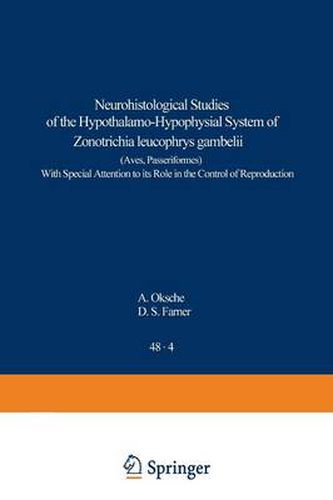Readings Newsletter
Become a Readings Member to make your shopping experience even easier.
Sign in or sign up for free!
You’re not far away from qualifying for FREE standard shipping within Australia
You’ve qualified for FREE standard shipping within Australia
The cart is loading…






This title is printed to order. This book may have been self-published. If so, we cannot guarantee the quality of the content. In the main most books will have gone through the editing process however some may not. We therefore suggest that you be aware of this before ordering this book. If in doubt check either the author or publisher’s details as we are unable to accept any returns unless they are faulty. Please contact us if you have any questions.
The anatomical description of the hypothalamo-hypophysial system of the White-crowned Sparrow, Zonotrichia leucophrys gambelii, as presented in this treatise, is by no means of definitive nature. Research in this area, in our own laboratories and elsewhere, continues at such a pace and is sufficiently in flux as to preclude the possibility of definitive morphological and functional conclu- sions at this time. Nevertheless, we do believe that there is now some genuinely heuristic value in a presentation of our neuroanatomical material. Most of this material is derived from the above-mentioned species which has received primary attention in our experimental investigations. In the course of our studies, it has become clear that the hypothalamo- hypophysial system of birds has attained morphological differentiation and spe- cialization as extensive as that of mammals. In order not to lose sight of the basic pattern of the system, comparative aspects must be brought into con- sideration. With this in mind we emphasize the fundamental contributions of Huber and Crosby, Kuhlenbeck, Benoit, Assenmacher and vVingstrand. The ana- tomical nomenclature of the avian hypothalamus has been critically examined and rationalized, to the extent possible, from a comparative view-point. In recent years this nomenclature has developed in such an independent and isolated manner that the confusion created can no longer be ignored. ‘Ve dedicate our treatise to the memory of Professor Ernst Scharrer who originally stimulated our investigations.
$9.00 standard shipping within Australia
FREE standard shipping within Australia for orders over $100.00
Express & International shipping calculated at checkout
This title is printed to order. This book may have been self-published. If so, we cannot guarantee the quality of the content. In the main most books will have gone through the editing process however some may not. We therefore suggest that you be aware of this before ordering this book. If in doubt check either the author or publisher’s details as we are unable to accept any returns unless they are faulty. Please contact us if you have any questions.
The anatomical description of the hypothalamo-hypophysial system of the White-crowned Sparrow, Zonotrichia leucophrys gambelii, as presented in this treatise, is by no means of definitive nature. Research in this area, in our own laboratories and elsewhere, continues at such a pace and is sufficiently in flux as to preclude the possibility of definitive morphological and functional conclu- sions at this time. Nevertheless, we do believe that there is now some genuinely heuristic value in a presentation of our neuroanatomical material. Most of this material is derived from the above-mentioned species which has received primary attention in our experimental investigations. In the course of our studies, it has become clear that the hypothalamo- hypophysial system of birds has attained morphological differentiation and spe- cialization as extensive as that of mammals. In order not to lose sight of the basic pattern of the system, comparative aspects must be brought into con- sideration. With this in mind we emphasize the fundamental contributions of Huber and Crosby, Kuhlenbeck, Benoit, Assenmacher and vVingstrand. The ana- tomical nomenclature of the avian hypothalamus has been critically examined and rationalized, to the extent possible, from a comparative view-point. In recent years this nomenclature has developed in such an independent and isolated manner that the confusion created can no longer be ignored. ‘Ve dedicate our treatise to the memory of Professor Ernst Scharrer who originally stimulated our investigations.